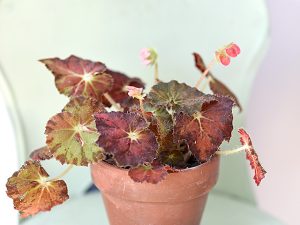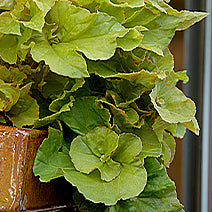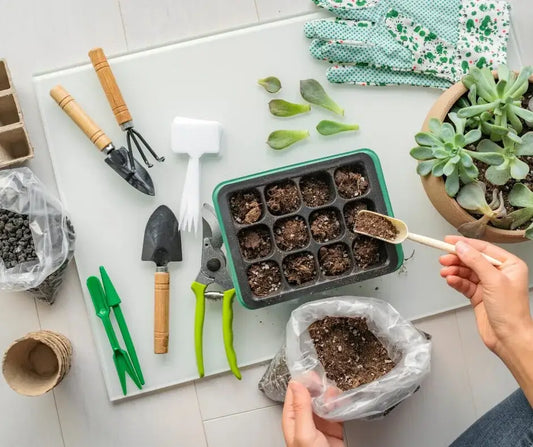 Why are begonias big right now? Maybe because they have personality. Unlike all those placeholder foliage plants that sit in the corner looking pretty darn blah (yawn), begonias step out of the shadows and say something. Talk about diversity: Begonias boast leaf shapes beyond your craziest imagination. From angel wings to bat wings, from pond lily-like to maple-shaped, from rippled to curly to corkscrew to ruffled to sleek with eyelashes or furry or felted or hairy or smooth—begonias cover the gamut. They grow upright or they creep along the ground. They might be sufficiently small to conveniently fit on a windowsill or so seriously large that they bogart a window. You can host them in a terrarium or let them enjoy the breezes of an open window (when temperatures are above 55° F). See what we mean about variety? Beyond being downright fascinating, begonias make great houseplants—and that fact was established long ago when homes initially began hosting plants. As soon as houses were warm enough to make these very tender plants feel at home, begonias were welcomed into the family. Why? Because they don’t require a whole lot of bright sunlight to thrive—and that can be the deciding factor for houseplant hosting. An east or west-facing window is absolutely fine with begonias. In fact, they don’t want blasting sun from a south-facing fenestration. And begonias are long-lived plants—they can survive for generations. If you inherited your granny’s pond lily begonia or maybe her angel wing, you know what we mean.
Why are begonias big right now? Maybe because they have personality. Unlike all those placeholder foliage plants that sit in the corner looking pretty darn blah (yawn), begonias step out of the shadows and say something. Talk about diversity: Begonias boast leaf shapes beyond your craziest imagination. From angel wings to bat wings, from pond lily-like to maple-shaped, from rippled to curly to corkscrew to ruffled to sleek with eyelashes or furry or felted or hairy or smooth—begonias cover the gamut. They grow upright or they creep along the ground. They might be sufficiently small to conveniently fit on a windowsill or so seriously large that they bogart a window. You can host them in a terrarium or let them enjoy the breezes of an open window (when temperatures are above 55° F). See what we mean about variety? Beyond being downright fascinating, begonias make great houseplants—and that fact was established long ago when homes initially began hosting plants. As soon as houses were warm enough to make these very tender plants feel at home, begonias were welcomed into the family. Why? Because they don’t require a whole lot of bright sunlight to thrive—and that can be the deciding factor for houseplant hosting. An east or west-facing window is absolutely fine with begonias. In fact, they don’t want blasting sun from a south-facing fenestration. And begonias are long-lived plants—they can survive for generations. If you inherited your granny’s pond lily begonia or maybe her angel wing, you know what we mean. So how do you host a begonia? As with all houseplants, start with good potting soil. Begonias dote on a light, friable potting soil with plenty of peat—like Coast of Maine’s Bar Harbor Blend Organic & Natural Potting Soil. Because begonia roots grow horizontally rather than plunging down, you’ll want to give your begonia a shallow container rather than a deep pot. That’s especially important for the rhizomatous and rex begonias. A porous clay container is their favorite and feel free to fertilize once every 3-4 weeks from March 1st through Thanksgiving with a food such as Coast of Maine’s Liquid Squid Fertilizer for Indoor Plants watering in according to the label instructions. Don’t spray the leaves. And begonias prefer to dry out between waterings, so wait until the soil is slightly dry before giving the plant its next drink.
So how do you host a begonia? As with all houseplants, start with good potting soil. Begonias dote on a light, friable potting soil with plenty of peat—like Coast of Maine’s Bar Harbor Blend Organic & Natural Potting Soil. Because begonia roots grow horizontally rather than plunging down, you’ll want to give your begonia a shallow container rather than a deep pot. That’s especially important for the rhizomatous and rex begonias. A porous clay container is their favorite and feel free to fertilize once every 3-4 weeks from March 1st through Thanksgiving with a food such as Coast of Maine’s Liquid Squid Fertilizer for Indoor Plants watering in according to the label instructions. Don’t spray the leaves. And begonias prefer to dry out between waterings, so wait until the soil is slightly dry before giving the plant its next drink. How to choose your begonia buddy/housemate? You’ll have plenty of options. Some of the easiest begonias are the rhizomatous types that send creeping caterpillar-like rhizomes over the top of the soil surface. They blossom in late winter (now!), producing sprays of adorable white, pink, or salmon flowers. With a size range that goes the scope from itty bitty versions with thumbnail-sized leaves that remain under 6 inches in height to larger plants with leaves that span 8 inches or more, you’ve got a lot of diversity. They don’t demand high humidity, but a very dry atmosphere might not be to their liking.
How to choose your begonia buddy/housemate? You’ll have plenty of options. Some of the easiest begonias are the rhizomatous types that send creeping caterpillar-like rhizomes over the top of the soil surface. They blossom in late winter (now!), producing sprays of adorable white, pink, or salmon flowers. With a size range that goes the scope from itty bitty versions with thumbnail-sized leaves that remain under 6 inches in height to larger plants with leaves that span 8 inches or more, you’ve got a lot of diversity. They don’t demand high humidity, but a very dry atmosphere might not be to their liking. The more colorful rex begonias are those high-profile houseplants with leaves banded in multiple shades from bronze to glowing silver and green. Although their flashy shades make them ultra-tempting, they are prone to powdery mildew and are more finicky than their rhizomatous kin. On the other hand, tried-and-true angel wing types are easy to please and stand upright. They have long, graceful, winged leaves—plus many boast the additional perk of producing umbels of flowers in shades of red, pink, orange, white, etc. They really are riveting. And again, the size range varies from a foot or so to several feet in height.
The more colorful rex begonias are those high-profile houseplants with leaves banded in multiple shades from bronze to glowing silver and green. Although their flashy shades make them ultra-tempting, they are prone to powdery mildew and are more finicky than their rhizomatous kin. On the other hand, tried-and-true angel wing types are easy to please and stand upright. They have long, graceful, winged leaves—plus many boast the additional perk of producing umbels of flowers in shades of red, pink, orange, white, etc. They really are riveting. And again, the size range varies from a foot or so to several feet in height. So you’ve got options galore. There’s something for everyone’s taste. And begonias can go outdoors in a shady position (under trees, on a shady patio, in a covered gazebo) during the summer when nighttime temperatures are reliably over 55° F. And when you want to share your prize with friends and relatives, they’re easy to propagate because when folks see your begonia, you know they’ll come begging for cuttings. So go for it.
So you’ve got options galore. There’s something for everyone’s taste. And begonias can go outdoors in a shady position (under trees, on a shady patio, in a covered gazebo) during the summer when nighttime temperatures are reliably over 55° F. And when you want to share your prize with friends and relatives, they’re easy to propagate because when folks see your begonia, you know they’ll come begging for cuttings. So go for it. Written by award winning author, Tovah Martin. Photos also taken by Tovah Martin. Find her books and more information on her website: tovahmartin.com.













